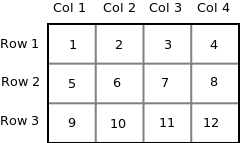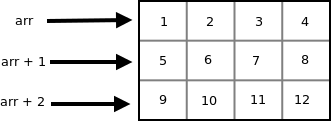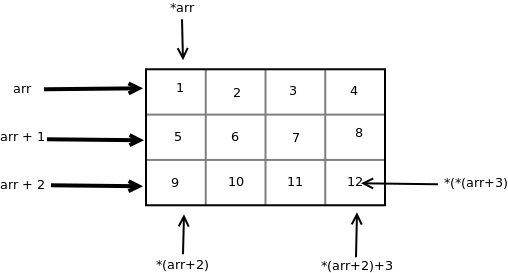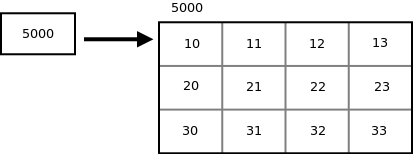Array and pointer/array of pointer vs pointer to array:
Taken from this link for caching: https://www.geeksforgeeks.org/pointer-array-array-pointer/
Pointer to Array
Consider the following program:#include<stdio.h> int main() { int arr[5] = { 1, 2, 3, 4, 5 }; int *ptr = arr; printf("%p\n", ptr); return 0; } |
Syntax:
data_type (*var_name)[size_of_array];Example:
int (*ptr)[10];Here ptr is pointer that can point to an array of 10 integers. Since subscript have higher precedence than indirection, it is necessary to enclose the indirection operator and pointer name inside parentheses. Here the type of ptr is ‘pointer to an array of 10 integers’.
Note : The pointer that points to the 0th element of array and the pointer that points to the whole array are totally different. The following program shows this:
// C program to understand difference between // pointer to an integer and pointer to an // array of integers. #include<stdio.h> int main() { // Pointer to an integer int *p; // Pointer to an array of 5 integers int (*ptr)[5]; int arr[5]; // Points to 0th element of the arr. p = arr; // Points to the whole array arr. ptr = &arr; printf("p = %p, ptr = %p\n", p, ptr); p++; ptr++; printf("p = %p, ptr = %p\n", p, ptr); return 0; } |
p = 0x7fff4f32fd50, ptr = 0x7fff4f32fd50 p = 0x7fff4f32fd54, ptr = 0x7fff4f32fd64p: is pointer to 0th element of the array arr, while ptr is a pointer that points to the whole array arr.
- The base type of p is int while base type of ptr is ‘an array of 5 integers’.
- We know that the pointer arithmetic is performed relative to the base size, so if we write ptr++, then the pointer ptr will be shifted forward by 20 bytes.

On dereferencing a pointer expression we get a value pointed to by that pointer expression. Pointer to an array points to an array, so on dereferencing it, we should get the array, and the name of array denotes the base address. So whenever a pointer to an array is dereferenced, we get the base address of the array to which it points.
// C program to illustrate sizes of // pointer of array #include<stdio.h> int main() { int arr[] = { 3, 5, 6, 7, 9 }; int *p = arr; int (*ptr)[5] = &arr; printf("p = %p, ptr = %p\n", p, ptr); printf("*p = %d, *ptr = %p\n", *p, *ptr); printf("sizeof(p) = %lu, sizeof(*p) = %lu\n", sizeof(p), sizeof(*p)); printf("sizeof(ptr) = %lu, sizeof(*ptr) = %lu\n", sizeof(ptr), sizeof(*ptr)); return 0; } |
p = 0x7ffde1ee5010, ptr = 0x7ffde1ee5010 *p = 3, *ptr = 0x7ffde1ee5010 sizeof(p) = 8, sizeof(*p) = 4 sizeof(ptr) = 8, sizeof(*ptr) = 20
Pointer to Multidimensional Arrays
- Pointers and two dimensional Arrays: In a two dimensional
array, we can access each element by using two subscripts, where first
subscript represents the row number and second subscript represents the
column number. The elements of 2-D array can be accessed with the help
of pointer notation also. Suppose arr is a 2-D array, we can access any
element arr[i][j] of the array using the pointer expression *(*(arr + i) + j). Now we’ll see how this expression can be derived.
Let us take a two dimensional array arr[3][4]:int arr[3][4] = { {1, 2, 3, 4}, {5, 6, 7, 8}, {9, 10, 11, 12} };
Since memory in computer is organized linearly it is not possible to store the 2-D array in rows and columns. The concept of rows and columns is only theoretical, actually a 2-D array is stored in row major order i.e rows are placed next to each other. The following figure shows how the above 2-D array will be stored in memory.

Each row can be considered as a 1-D array, so a two-dimensional array can be considered as a collection of one-dimensional arrays that are placed one after another. In other words we can say that a 2-D dimensional arrays that are placed one after another. So here arr is an array is an array of 3 elements where each element is a 1-D array of 4 integers.
We know that the name of an array is a constant pointer that points to 0th 1-D array and contains address 5000. Since arr is a ‘pointer to an array of 4 integers’, according to pointer arithmetic the expression arr + 1 will represent the address 5016 and expression arr + 2 will represent address 5032.
So we can say that arr points to the 0th 1-D array, arr + 1 points to the 1st 1-D array and arr + 2 points to the 2nd 1-D array.


In general we can write:
arr + i Points to ith element of arr -> Points to ith 1-D array
- Since arr + i points to ith element of arr, on dereferencing it will get ith element of arr which is of course a 1-D array. Thus the expression *(arr + i) gives us the base address of ith 1-D array.
- We know, the pointer expression *(arr + i) is equivalent to the subscript expression arr[i]. So *(arr + i) which is same as arr[i] gives us the base address of ith 1-D array.

In general we can write:
*(arr + i) - arr[i] - Base address of ith 1-D array -> Points to 0th element of ith 1-D array
Note: Both the expressions (arr + i) and *(arr + i) are pointers, but their base type are different. The base type of (arr + i) is ‘an array of 4 units’ while the base type of *(arr + i) or arr[i] is int.
- To access an individual element of our 2-D array, we should be able to access any jth element of ith 1-D array.
- Since the base type of *(arr + i) is int and it contains the address of 0th element of ith 1-D array, we can get the addresses of subsequent elements in the ith 1-D array by adding integer values to *(arr + i).
- For example *(arr + i) + 1 will represent the address of 1st element of 1stelement of ith 1-D array and *(arr+i)+2 will represent the address of 2nd element of ith 1-D array.
- Similarly *(arr + i) + j will represent the address of jth element of ith 1-D array. On dereferencing this expression we can get the jth element of the ith 1-D array.


Output:// C program to print the values and// address of elements of a 2-D array#include<stdio.h>intmain(){intarr[3][4] = {{ 10, 11, 12, 13 },{ 20, 21, 22, 23 },{ 30, 31, 32, 33 }};inti, j;for(i = 0; i < 3; i++){printf("Address of %dth array = %p %p\n",i, arr[i], *(arr + i));for(j = 0; j < 4; j++)printf("%d %d ", arr[i][j], *(*(arr + i) + j));printf("\n");}return0;}
Address of 0th array = 0x7ffe50edd580 0x7ffe50edd580 10 10 11 11 12 12 13 13 Address of 1th array = 0x7ffe50edd590 0x7ffe50edd590 20 20 21 21 22 22 23 23 Address of 2th array = 0x7ffe50edd5a0 0x7ffe50edd5a0 30 30 31 31 32 32 33 33
- Pointers and Three Dimensional Arrays
In a three dimensional array we can access each element by using three subscripts. Let us take a 3-D array-
int arr[2][3][2] = { {{5, 10}, {6, 11}, {7, 12}}, {{20, 30}, {21, 31}, {22, 32}} };We can consider a three dimensional array to be an array of 2-D array i.e each element of a 3-D array is considered to be a 2-D array. The 3-D array arr can be considered as an array consisting of two elements where each element is a 2-D array. The name of the array arr is a pointer to the 0th 2-D array.

Thus the pointer expression *(*(*(arr + i ) + j ) + k) is equivalent to the subscript expression arr[i][j][k].
We know the expression *(arr + i) is equivalent to arr[i] and the expression *(*(arr + i) + j) is equivalent arr[i][j]. So we can say that arr[i] represents the base address of ith 2-D array and arr[i][j] represents the base address of the jth 1-D array.
Output:// C program to print the elements of 3-D// array using pointer notation#include<stdio.h>intmain(){intarr[2][3][2] = {{{5, 10},{6, 11},{7, 12},},{{20, 30},{21, 31},{22, 32},}};inti, j, k;for(i = 0; i < 2; i++){for(j = 0; j < 3; j++){for(k = 0; k < 2; k++)printf("%d\t", *(*(*(arr + i) + j) +k));printf("\n");}}return0;}
5 10 6 11 7 12 20 30 21 31 22 32
The following figure shows how the 3-D array used in the above program is stored in memory.

Subscripting Pointer to an Array
Suppose arr is a 2-D array with 3 rows and 4 columns and ptr is a pointer to an array of 4 integers, and ptr contains the base address of array arr.int arr[3][4] = {{10, 11, 12, 13}, {20, 21, 22, 23}, {30, 31, 32, 33}};
int (*ptr)[4];
ptr = arr;

Since ptr is a pointer to an array of 4 integers, ptr + i will point to ith row. On dereferencing ptr + i, we get base address of ith row. To access the address of jth element of ith row we can add j to the pointer expression *(ptr + i). So the pointer expression *(ptr + i) + j gives the address of jth element of ith row and the pointer expression *(*(ptr + i)+j) gives the value of the jth element of ith row.
We know that the pointer expression *(*(ptr + i) + j) is equivalent to subscript expression ptr[i][j]. So if we have a pointer varible containing the base address of 2-D array, then we can access the elements of array by double subscripting that pointer varible.
// C program to print elements of a 2-D array // by scripting a pointer to an array #include<stdio.h> int main() { int arr[3][4] = { {10, 11, 12, 13}, {20, 21, 22, 23}, {30, 31, 32, 33} }; int (*ptr)[4]; ptr = arr; printf("%p %p %p\n", ptr, ptr + 1, ptr + 2); printf("%p %p %p\n", *ptr, *(ptr + 1), *(ptr + 2)); printf("%d %d %d\n", **ptr, *(*(ptr + 1) + 2), *(*(ptr + 2) + 3)); printf("%d %d %d\n", ptr[0][0], ptr[1][2], ptr[2][3]); return 0; } |
0x7ffead967560 0x7ffead967570 0x7ffead967580 0x7ffead967560 0x7ffead967570 0x7ffead967580 10 22 33 10 22 33
Difference between pointer and array:
Most of the time, pointer and array accesses can be treated as acting the same, the major exceptions being:1) the sizeof operator
o sizeof(array) returns the amount of memory used by all elements in array
o sizeof(pointer) only returns the amount of memory used by the pointer variable itself
2) the & operator
o &array is an alias for &array[0] and returns the address of the first element in array
o &pointer returns the address of pointer
3) a string literal initialization of a character array
o char array[] = “abc” sets the first four elements in array to ‘a’, ‘b’, ‘c’, and ‘\0’
o char *pointer = “abc” sets pointer to the address of the “abc” string (which may be stored in read-only memory and thus unchangeable)
4) Pointer variable can be assigned a value whereas array variable cannot be.
int a[10]; int *p; p=a; /*legal*/ a=p; /*illegal*/5) Arithmetic on pointer variable is allowed.
p++; /*Legal*/ a++; /*illegal*/
No comments:
Post a Comment